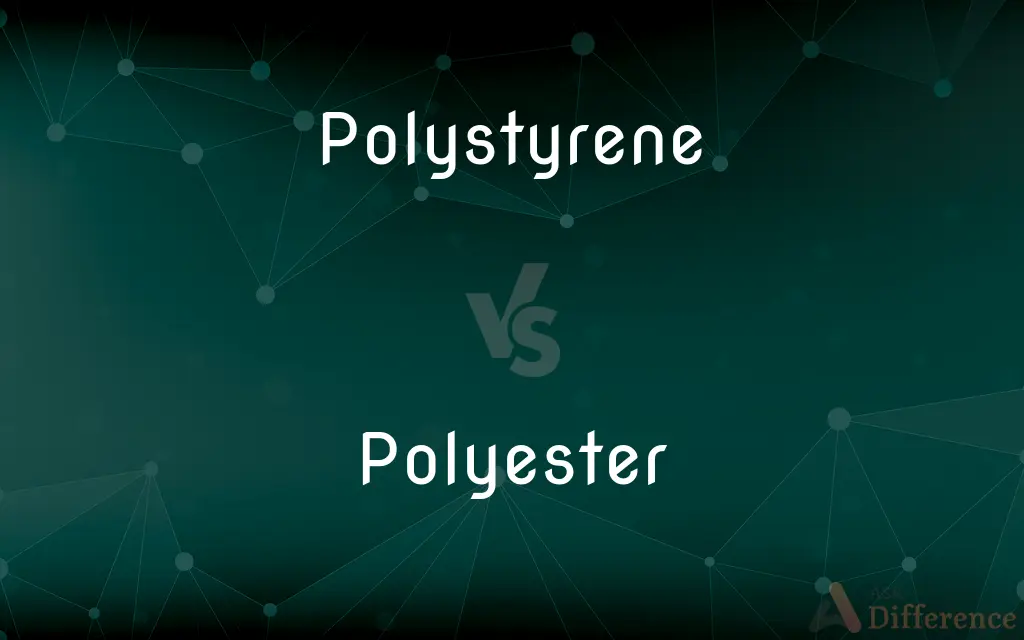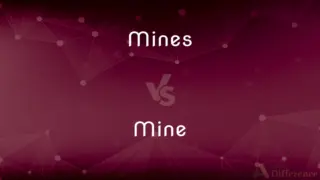Polystyrene vs. Polyester — What's the Difference?
Edited by Tayyaba Rehman — By Fiza Rafique — Updated on November 3, 2023
Polystyrene is a synthetic aromatic hydrocarbon polymer used for rigid products, while polyester is a category of polymers used in fibers and fabrics.

Difference Between Polystyrene and Polyester
Table of Contents
ADVERTISEMENT
Key Differences
Polystyrene is a plastic material commonly used for its rigidity in products like disposable cutlery, CD cases, and insulation. Polyester, however, refers to a group of polymers used primarily in textiles, providing durability, resistance to stretching and shrinking, and quick-drying properties. While polystyrene is often found in solid form, polyester is typically found as fibers or fabrics. Both are synthetic but serve different applications in daily life.
In the packaging industry, polystyrene is valued for its lightweight and insulating properties, making it ideal for food packaging and shipping materials. Polyester stands out in the clothing industry, where its fibers are woven into fabrics for apparel and home furnishings. Polystyrene's structure lends itself to strong, static objects, whereas polyester's flexibility makes it suitable for a wide range of textile applications.
Environmental considerations for both materials are significant; polystyrene is notorious for being less biodegradable, contributing to pollution. Polyester, while also synthetic, can be recycled more readily and is increasingly available in recycled forms. Both polystyrene and polyester pose challenges for waste management, but efforts to recycle polyester have been more successful due to its widespread use in clothing.
Production processes for polystyrene and polyester are quite different. Polystyrene is produced through the polymerization of styrene, a derivative of petroleum. Polyester is created through a chemical reaction involving petroleum, air, and water. This difference in production reflects their divergent characteristics; polystyrene is generally more brittle, while polyester fibers exhibit flexibility and tensile strength.
Both polystyrene and polyester are versatile materials that have changed manufacturing and consumer products. Polystyrene's utility in disposable items and insulation contrasts with polyester's role in creating long-lasting goods. Despite their synthetic origins, the development of biodegradable polystyrene and eco-friendly polyester shows an evolving commitment to sustainability within their respective uses.
ADVERTISEMENT
Comparison Chart
Material Type
Aromatic hydrocarbon polymer.
Category of polymers.
Common Uses
Insulation, disposable items.
Textiles, clothing, furnishings.
Texture
Usually rigid and brittle.
Flexible and textile-like.
Environmental Impact
Less biodegradable, hard to recycle.
More easily recycled, especially fibers.
Production
Polymerization of styrene.
Chemical reaction involving petroleum, air, and water.
Compare with Definitions
Polystyrene
Can be transparent or foam-like in appearance.
The clear polystyrene box displayed the product well.
Polyester
Often utilized for its strength and resistance to wrinkles and shrinking.
Polyester curtains are popular for their durability.
Polystyrene
Sometimes expanded for packing materials to protect goods.
The delicate vase was packed in expanded polystyrene to prevent damage.
Polyester
Used in various applications due to its versatile properties.
The outdoor tent was made from a waterproof polyester fabric.
Polystyrene
Often used for thermal insulation material in building construction.
We installed polystyrene insulation in the attic.
Polyester
Also refers to the textile made from these synthetic fibers.
He prefers polyester bed sheets for easy care.
Polystyrene
A material used in the production of disposable foam cups and plates.
The picnic supplies included polystyrene cups.
Polyester
Can be combined with natural fibers to create blended materials.
The sweater was a blend of wool and polyester.
Polystyrene
A rigid plastic polymer used for making various products.
The polystyrene container kept the coffee hot.
Polyester
Polyester is a category of polymers that contain the ester functional group in every repeat unit of their main chain. As a specific material, it most commonly refers to a type called polyethylene terephthalate (PET).
Polystyrene
Polystyrene (PS) is a synthetic aromatic hydrocarbon polymer made from the monomer known as styrene. Polystyrene can be solid or foamed.
Polyester
A synthetic resin in which the polymer units are linked by ester groups, used chiefly to make synthetic textile fibres.
Polystyrene
A rigid clear thermoplastic polymer of styrene that can be molded into objects or made into a foam that is used as thermal insulation.
Polyester
Any of numerous synthetic polymers produced chiefly by reaction of dicarboxylic acids with dihydric alcohols and used primarily as light, strong, weather-resistant resins in boat hulls, textile fibers, adhesives, and molded parts.
Polystyrene
(organic chemistry) A vinylic polymer of styrene, CH2CHphenyl.
Polyester
A wrinkle-resistant fabric of fibers made from any of these resins.
Polystyrene
(organic chemistry) An alkane chain of benzene molecules, RCH2CHphenylR.
Polyester
Any polymer whose monomers are linked together by ester bonds
Polystyrene
A polymer of styrene; a rigid transparent thermoplastic;
Expanded polystyrene looks like a rigid white foam and is used as packing or insulation
Polyester
A material or fabric made from polyester polymer
Polyester
Of, or consisting of polyesters
Polyester
Any of numerous synthetic resins; they are light and strong and weather resistant
Polyester
A complex ester used for making fibers or resins or plastics or as a plasticizer
Polyester
Any of a large class of synthetic fabrics
Polyester
A category of synthetic fibers used in textile production.
Her dress is made of 100% polyester.
Common Curiosities
Are polystyrene products biodegradable?
Polystyrene is not readily biodegradable and can persist in the environment.
What is the production process for polyester?
Polyester is produced through a chemical reaction involving petroleum, air, and water.
Are all polystyrene products foam-like?
No, polystyrene can also be found in a solid, transparent form.
Can polystyrene be used in clothing?
No, polystyrene is not used in clothing due to its rigidity.
What is polystyrene commonly used for?
Polystyrene is used for disposable cutlery, packaging, and insulation.
What are the primary uses of polyester?
Polyester is primarily used for textiles, clothing, and home furnishings.
Is polystyrene recyclable?
Polystyrene is less commonly recycled due to processing challenges.
Can polyester be recycled?
Yes, polyester, especially fibers, can be recycled more easily than polystyrene.
How is polystyrene made?
Polystyrene is made through the polymerization of styrene monomers.
Is polystyrene harmful to humans?
Polystyrene can release toxic substances if heated and should not be used with hot foods.
Is polyester only used in clothing?
No, polyester is also used in a variety of other products, including containers and films.
What environmental impact does polyester have?
Polyester's environmental impact includes potential microplastic pollution but is mitigated by recycling efforts.
Is polyester good for insulation?
Polyester can be used for insulation, especially in textiles, but it's not as effective as polystyrene for thermal insulation.
Can polystyrene be composted?
No, polystyrene cannot be composted and does not break down easily in compost systems.
What are the care instructions for polyester fabrics?
Polyester fabrics are generally machine washable and easy to care for.
Share Your Discovery

Previous Comparison
Mines vs. Mine
Next Comparison
Meme vs. TrollAuthor Spotlight
Written by
Fiza RafiqueFiza Rafique is a skilled content writer at AskDifference.com, where she meticulously refines and enhances written pieces. Drawing from her vast editorial expertise, Fiza ensures clarity, accuracy, and precision in every article. Passionate about language, she continually seeks to elevate the quality of content for readers worldwide.
Edited by
Tayyaba RehmanTayyaba Rehman is a distinguished writer, currently serving as a primary contributor to askdifference.com. As a researcher in semantics and etymology, Tayyaba's passion for the complexity of languages and their distinctions has found a perfect home on the platform. Tayyaba delves into the intricacies of language, distinguishing between commonly confused words and phrases, thereby providing clarity for readers worldwide.
















































